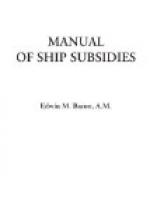In 1909 (law of June 14) the system was extended with the addition of general navigation bounties calling for an annual expenditure of 2,750,000 pesetas ($530,750). For ships making monthly sailings to various named points, among them Brazil, Uruguay, and the Argentines, and semi-weekly sailings to Algeria, bounties were provided ranging from seven to seventeen cents per ton gross for every thousand miles run, to continue for a period of ten years. Spanish ships manned by Spanish crews and ranked by maritime agencies as first class were made eligible to them. All ships receiving these bounties must admit naval cadets and perform certain services for the Government. To shipbuilders, as off-set to the duties on imported materials which they must pay, bounties for port materials as well as for ships were granted by this law. The construction subsidies were increased to $13.84 per gross ton for wooden ships not possessing their own motor power, and $17.30 self-propelling; $20.76 for iron or steel ships without motor, $27.68 for ships for freight only, $29.41, freight and passengers; and $32 passengers only. Ten per cent of the bounties for passenger ships was to be added for each knot made above fourteen per hour. The sale of a ship to a foreigner within two years after the ship’s construction was made invalid unless about a third of the bounty received be repaid. Ships built abroad for Spanish citizens were to be relieved of certain duties “provided it appears that it was absolutely necessary that they be built abroad."[ED]
The total amount paid in mail subventions in 1910 was $1,858,186; in navigation subsidies, $1,291,826. The total Spanish tonnage the same year comprised 579 vessels of 765,460 tons.[EE]
* * * * *
Portugal grants postal subventions of comparatively small amounts to three steamship companies which perform all her mail carrying. A move toward the institution of a general subsidy system was made in 1899, when a bill was before the Cortes providing construction and navigation bounties for the encouragement of domestic shipbuilding and ship-using; but this measure was not enacted. In 1911 the republic offered a subsidy of one thousand dollars per voyage in either direction for steamship service between Lisbon and New York, with call at the Azores, the contract to run for three years.[EF] Portugal controls her shipping service with her colonies, the trade with them being restricted to the Portuguese flag.[EG] Her total tonnage is small: in 1910 only 110,183 tons.[EH]
FOOTNOTES:
[Footnote DZ: U.S. Con. Rept., no. 112, January, 1890, pp. 54-56.]
[Footnote EA: U.S. Vice Con. Gen. William Dawson jr., Con. Repts., no. 349, Oct., 1910.]
[Footnote EB: U.S. Con. Repts., 1890.]
[Footnote EC: Meeker.]
[Footnote ED: U.S. Con. Rept., no. 349, Oct., 1909.]




